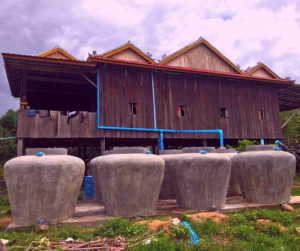Half of Cambodia’s rural population – more than six million people – lack access to clean water. It’s a combination of two main issues. One is climate change, which has brought about significant drought. The other is an unreliable supply of clean water, due to unsafe water sources or systems, surface water contamination and the often inaccessibility of spring and groundwater. But there is rain. And whilst climate change is responsible for reducing the volume of rainfall in Cambodia, it is still a water source of great value. And need. EWB Australia has been working with Rainwater Cambodia (RWC) to catch more rain – in a Jumbo Jar.
Since 2015, EWB Australia has been working with RWC, Cambodian Rural Development Team (CRDT) and local communities to address the scarcity of water in remote rural villages. Most recently, the pilot and trial of an Underground Rainwater Tank in 2019-2020 in the Kampong Speu province explored one solution to water collection and storage in this challenging environment.
A range of different systems to capture rainwater have been trialled and implemented across rural Cambodia – a reflection of the different solutions that need to be designed due to the disparate environments. More than 2500 domestic and 300 institutional systems have now been installed. In the villages, water is used for drinking and cooking, and year-round supply is needed. But for communities in Kratie province, in the northwest of Cambodia, current needs are not being met by existing storage units. This is due to the small capacity of current storage systems, and the high cost to purchase larger ones.
In June 2020, RWC and CRDT were commissioned by EWB Australia to implement a second trial of rainwater harvesting, to address this particular challenge.
Catching rainwater for an island

Jumbo Jars installed for a home housing four families.
Kampong Rotest village is an island on the Mekong River in Kratie Province. There, 195 families live and make their livelihoods through farming, fishing and rearing animals. Despite being surrounded by water, clean water is scarce.
Two households in the village were engaged to trial a specific type of rainwater collection device – giant clay jars, the height of a human, that can hold 25 cubic metres of water. The jumbo jar system was the preferred device, as its modular design allows for different sizing and customisation based on its use. The ability to produce good quality clay jars is also widespread in Cambodia.
Working with two very different homes – one with three family members, and the other housing four families with 19 people – ensured that the ability for these jars to collect and supply enough water for differing household sizes and needs could truly be tested.
Community consultation ensured that many more members of the village were on board with the trial, and eager to contribute to the project. Engaging broader community involvement is critical in order for them to learn about the technology and be a part of training to ensure the future sustainability (operations and maintenance) of the Jumbo Jars by people in their villages.
The project was not without its challenges. Welcome rainfall over the week of construction made digging underground soil and plastering of the clay soil walls of each jar difficult. The transportation of materials was also time-consuming. Although many materials were locally sourced, including bamboo as well as gravel and sand from the Mekong river, the province location – on an island on the Mekong – meant that boats and hand trucks were required to deliver the additional materials that were needed to the site.
Jumbo Jars performance
In January 2021, Pin and Mariny from EWB Australia’s Cambodia team visited Kampong Rotest village to see how the Jumbo Jars were performing. The feedback via interviews with members of these households was that they were very happy with the system, with other members of the community keen to have them installed.
One of the families shared how this Jumbo Jars have impacted their community: “This is the first time that my family and community have had clean water to use, and reduce the infection of intestinal disease, diarrhea and vomiting. We deeply thank the donors for providing the Jumbo Jar.”
So far the Jumbo Jars have only been filled to 40% of their capacity, as construction finished late in the rainy season and so the full capacity of rainwater able to be captured was not realised. This has meant that the Jumbo Jars are currently only able to meet the drinking water needs of these households (and not additional needs, such as for irrigation or water for livestock). The rainy season in Cambodia runs from May to October, a time which brings some three-quarters of Cambodia’s annual rainfall. The next rainy season will test the ability for the Jumbo Jars to realise all household water needs. Small improvements, such as changes to pipework to enable better flows during heavy downpours, and refinement of the filtration system to reduce solid impurities, was also discussed.
EWB Australia is also monitoring and analysing the storage efficiency of the systems, including the quantity of rainwater available, the household consumption requirements and the timing of both. Such analysis will determine the optimal size of each customised system. When systems are customised well, it reduces unnecessary costs and use of land, and addresses the real needs of the users.
This project responds to the objectives of the Cambodian government’s National Action Plan which has a goal to ensure 100% access to improved rural water supply and sanitation in rural areas by 2025. However, the economic impact of COVID-19 may cause delays in expanding the provision of safe water to the whole population. Cover the next few years, technology development and refinement will be key factors in the in accelerating access to safe water and, ultimately, to reach the Sustainable Development Goals.
This program is supported by the Australian NGO Cooperation Program (ANCP) and through the generous support of the Price Family Foundation.


